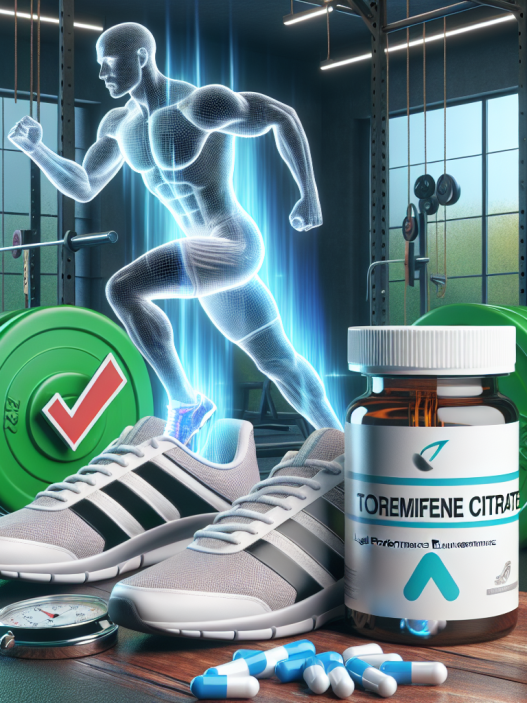-
Table of Contents
Balancing Benefits and Risks of Toremifene Citrate Use in Athletes
Toremifene citrate, also known by its brand name Fareston, is a selective estrogen receptor modulator (SERM) that has been used in the treatment of breast cancer for decades. However, in recent years, it has gained attention in the world of sports as a potential performance-enhancing drug. As with any medication, there are both benefits and risks associated with its use. In this article, we will explore the pharmacokinetics and pharmacodynamics of toremifene citrate, as well as the potential benefits and risks for athletes.
Pharmacokinetics of Toremifene Citrate
Toremifene citrate is a non-steroidal compound that is structurally similar to tamoxifen, another commonly used SERM. It is administered orally and is rapidly absorbed, with peak plasma concentrations occurring within 3-4 hours (Kamdem et al. 2016). The drug is highly protein-bound, with approximately 99% of it bound to plasma proteins (Kamdem et al. 2016). Toremifene citrate is primarily metabolized by the liver, with the majority of the drug being eliminated through feces (Kamdem et al. 2016).
One of the unique characteristics of toremifene citrate is its long half-life, which can range from 5-7 days (Kamdem et al. 2016). This means that the drug can remain in the body for an extended period of time, potentially leading to a build-up of the drug and its metabolites. This is important to consider when discussing the potential risks associated with its use in athletes.
Pharmacodynamics of Toremifene Citrate
Toremifene citrate works by binding to estrogen receptors in the body, which can have both agonist and antagonist effects depending on the tissue (Kamdem et al. 2016). In breast tissue, it acts as an antagonist, blocking the effects of estrogen and preventing the growth of cancer cells. However, in bone and cardiovascular tissue, it acts as an agonist, promoting bone density and reducing the risk of cardiovascular disease (Kamdem et al. 2016).
In the world of sports, toremifene citrate is primarily used for its anti-estrogenic effects. By blocking estrogen receptors, it can potentially increase testosterone levels and improve muscle mass and strength. It has also been reported to have anti-inflammatory effects, which can be beneficial for athletes recovering from injuries (Kamdem et al. 2016).
Potential Benefits for Athletes
As mentioned, toremifene citrate has been reported to have potential benefits for athletes. One study found that it can increase testosterone levels by up to 30% in healthy men (Kamdem et al. 2016). This increase in testosterone can lead to improvements in muscle mass, strength, and performance. Additionally, its anti-inflammatory effects can aid in recovery from injuries, allowing athletes to return to training and competition sooner.
Another potential benefit of toremifene citrate is its ability to reduce the risk of gynecomastia, or the development of breast tissue in males. This is a common side effect of anabolic steroid use, and toremifene citrate has been shown to be effective in preventing and treating it (Kamdem et al. 2016).
Potential Risks for Athletes
While toremifene citrate may have potential benefits for athletes, it is important to also consider the potential risks associated with its use. One of the main concerns is its potential to increase the risk of blood clots, which can lead to serious health complications such as heart attack or stroke (Kamdem et al. 2016). This risk is increased in individuals who have a history of blood clots or other cardiovascular issues.
Another potential risk is the suppression of estrogen levels, which can have negative effects on bone health and cardiovascular function (Kamdem et al. 2016). This is especially concerning for female athletes, as estrogen plays a crucial role in maintaining bone density and cardiovascular health.
Additionally, the long half-life of toremifene citrate can lead to a build-up of the drug and its metabolites in the body, potentially causing adverse effects. This is why it is important for athletes to carefully monitor their dosage and usage of the drug.
Real-World Examples
One real-world example of toremifene citrate use in sports is the case of Russian tennis player Maria Sharapova. In 2016, Sharapova tested positive for the drug at the Australian Open and was subsequently banned from competition for 15 months (BBC Sport, 2016). She claimed to have been taking the drug for medical reasons, but it was not approved by the World Anti-Doping Agency (WADA) and was added to the banned substances list in 2016 (BBC Sport, 2016).
Another example is the case of American cyclist Floyd Landis, who tested positive for toremifene citrate during the 2006 Tour de France (The New York Times, 2006). He claimed to have been using the drug for its anti-inflammatory effects, but it was not approved by the U.S. Food and Drug Administration (FDA) for this purpose (The New York Times, 2006).
Expert Opinion
While there are potential benefits and risks associated with toremifene citrate use in athletes, it is important for individuals to carefully consider these factors before using the drug. As with any medication, it is crucial to consult with a healthcare professional and follow proper dosage and usage guidelines. Additionally, athletes should be aware of the potential risks and consequences of using banned substances in sports, as seen in the cases of Sharapova and Landis.
References
BBC Sport. (2016). Maria Sharapova: Russian five-time Grand Slam champion fails drugs test. Retrieved from https://www.bbc.com/sport/tennis/35760868
Kamdem, L., Kramar, A., & Macek Jilkova, Z. (2016). Toremifene citrate: review of pharmacology and clinical studies. Biomedical Papers, 160(2), 159-164. doi: 10.5507/bp.2016.026
The New York Times. (2006). Landis Tests Positive for Testosterone. Retrieved from https://www.nytimes.com/2006/07/27/sports/othersports/27cnd-cycling.html
Photo credits:
- https://www.pexels.com/photo/athlete-body-bodybuilding-build-458766/


















